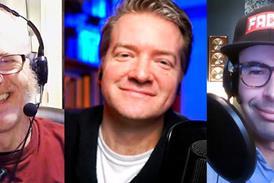Pastor and author Dan Salter explores the image-based atonement theory through an imagined conversation with CS Lewis about the birth, death and resurrection of Jesus
For more on CS Lewis’ theology, check out The CS Lewis Podcast here.
The phrase ‘mere Christianity’ was coined by Richard Baxter 300 years before C S Lewis borrowed it. Both Baxter and Lewis meant to describe the essentials of Christianity—as Lewis put it: “the belief that has been common to nearly all Christians at all times”. And almost all attempts at defining it include the belief that Jesus, through his earthly work of sinless life, death and resurrection, accomplished our reconciliation with God.
In other words, the atonement, most of us affirm, is the central and binding doctrine of our Christian faith. And yet, we still struggle with that definition. What is the atonement exactly? How did Jesus bring us to God?
Most of the many atonement theories have holes (which is why we have so many theories). But cross-cutting through the spectrum of ideas, a little known, yet clarifying theory asserts itself—the image-based atonement. By recognising the image-bearing construct in which humans pattern God, we find a separation, rather than a conflation, of forgiveness and redemption. This separation, then, satisfies both the “cancellation of an unpaid debt” requirement of forgiveness (to relieve the spirit of its sin guilt) while still insisting on the necessity of atonement for the sake of redemption of the cursed body (physical essence).
This article, rather than approaching the subject from a purely academic view, imagines a conversation between the author and C S Lewis in a hallway, Lewis’ well-known metaphor for ‘mere’ Christianity.
Read more:
CS Lewis on Christmas
3 former atheists walking the path of CS Lewis
Does God explain moral facts better than atheism?
From the hallway
“No, no. That’s not what I mean,” he said with cigarette ash dropping. Lewis almost never smoked as he walked, but he had suddenly remembered an appointment moments after he lit up, and now he was striding down the hall from his office, cigarette still in hand. “When I say ‘mere’ Christianity, I mean an agreed or common or central Christianity—the belief that has been common to nearly all Christians at all times.”
“And I understand that,” I answered, trying to match his pace. I had been in his office delivering a book—something of Boswell’s—and I took the opportunity to ask him about the atonement—precisely, about how so many views of the atonement in the world could fit together within his idea of ‘mere’ Christianity. At that, he had popped up suddenly, remembering his appointment, and invited me along. It was only down the hall, though the hallway was lengthy.
I tried to clarify: “But after you say that ‘mere’ Christianity, the central idea of Christian belief, is ‘that Christ’s death has somehow put us right with God and given us a fresh start,’ you seem to become almost dismissive about exactly how Christ’s death actually works to return us to right relationship.”
Lewis shook his head. “I’m not dismissive of the atonement at all. In fact, I specifically said in … in my book that ‘mere’ Christianity is not an alternative to the creeds or any other beliefs within Christianity. It is more like a hall—like this hall—out of which doors open into several rooms. My focus in the book is that if I bring anyone into the hall, I shall have done what I attempted. But I still acknowledge it is in the rooms, not in the hall, that the living goes on. Off the hall in a house, for example, there are fires and chairs and meals. In those rooms, you find fuller appreciation of the whole house. So that’s what the idea of the atonement is to Christianity—it’s the hall. It’s the central belief, but just how it occurs moves you into a room—beyond the hall of what has been common to all Christians of all times.”
“But still,” I floundered, “Christianity is not just a faith exercise. It’s … it’s relationship.”
He furrowed his brow at that. “And your point?”
“Well, in a relationship, you know, or want to know, something about the one you’re having relationship with. ‘Mere’ Christianity speaks only of the what—what God did to rescue me—rather than also why he did it. God is love, and we know that not just because of the fact that he rescued, but because of why he rescued, which we get from the how. So … so wouldn’t knowing more about the why and how of atonement lead us to a deeper relationship?”
“Sure it would! But consider carefully what you just said—knowing more about the atonement would ‘lead us’ to a deeper relationship. The starting point is ‘mere’ Christianity. The movement from there—opening the door from the hallway to the room—is the deeper growth.”
We took a couple of steps in silence, but it still gnawed at me. Some of those hallway doors led to such different views of God from my own, and some made no sense at all, at least to me. “I guess my concern is that people will just stop at the ‘mere’ Christianity idea. They might … they could camp out in the hallway, perfectly satisfied to be in the house without exploring the rooms—or even seeing something wrong with exploring the rooms because the hall was deemed somehow more important. But working toward answers about the atonement seems vital for our satisfaction.”
Get access to exclusive bonus content & updates: register & sign up to the Premier Unbelievable? newsletter!
“Well, I agree to some extent. The how of the atonement is important. And I’ve struggled with various ideas of how it works. For example, I don’t think God transfers the guilt of our sin to Jesus and punishes him for it. Thinking that God’s honour or sense of justice can be satisfied by punishing the innocent makes little sense to me.”
I nodded vigorously. “Yes! It’s like a judge sentencing a man to die for his crime, and then the man’s mother stands up to say, ‘No, wait. I’ll take his punishment for him!’ There’s no way that judge would agree: ‘Okay, sure. As long as someone pays the sentence, I’m fine with that.’ If he did, he would soon be out of a job because punishing the innocent for the crime of the guilty is just not just. And the reason is that guilt cannot magically transfer from the guilty over to an innocent party.”
“Right,” Lewis said. “So my answer is that instead of the atonement being about punishment, we should understand it as ‘paying the penalty’ for our sin—like ‘paying a debt.’”
That took me aback. “Paying a debt?” I wondered aloud. “But I thought God forgives sin.”
“He … does.” Catching onto my thought, Lewis slowed his pace and then stopped. He was thinking.
“Forgiveness,” I pressed, “is the cancellation of an unpaid debt—not the demand for payment. What is there to forgive if Jesus already paid off our debt?”
He looked up quizzically. “So are you saying that the cross wasn’t necessary?”
“No, not at all. I’m saying that the cross’ obtaining God’s redemption shouldn’t be confused with God’s forgiveness for the guilt of sin. Didn’t God forgive sin in the Old Testament … before the cross?”
Lewis pondered. “You mean, like with the sacrifices?”
“With the sacrifices, yes,” I agreed. “Leviticus specifically says that. But also David in Psalm 85 cries out to God, ‘You took away Your people’s guilt,’ and in Psalm 32, ‘How joyful is the one whose transgression is forgiven’.”
“Well, in saying that, he could have been looking forward to the cross.
“But David sounds as if he knows the joy that comes from forgiveness. And what about Jesus then telling the paralytic, ‘Your sins are forgiven,’ not ‘will be once I die’?”
Abruptly, Lewis began walking again. “See, this is why discussion of the atonement slips out of the hallway and into the rooms. The atonement has deeper things to consider than what is necessary for ‘mere’ Christianity.”
“I don’t disagree!” I shot back, frustrated that he dropped my point. “I’m just saying the atonement is still an important discussion.”
“But can we really understand all the intricate workings of God?”
I was surprised at his seeming indifference. “If he gives them to us—reveals those workings in scripture—we are bound in love and devotion to sift through as best we can.”
“But our best may not be good enough.”
Again, we walked a few paces without speaking, and again, I broke the silence. “Maybe we’re looking at it wrong. What about the idea of image-based atonement?”
“What exactly is that?”
“The way I understand it is … so God has no physical body, right? But even so, our image of him does not ignore the material; physical creation does, in fact, play a role. The traditional understanding of God’s construct is as Trinity: one essence and three persons. In his essence—that oneness shared by all three persons—is infinite truth, goodness and beauty, which are those categorical summations of all virtue. So each person of the Trinity—each with his own mind and will—may decide and act exclusively based on that one shared essence. But since that shared essence is infinite in knowledge, goodness and beauty, each person of the Godhead always moves in harmony with the others. Each draws on the infinite of those categories, so no one of them could come to an opposing conclusion.”
“That makes sense,” Lewis confessed, “but what of it? How does this relate to atonement?”
“It will, but I need a minute. I’m talking about the imaging first, and then we can apply it to the atonement.”
I tried to arrange my thoughts and then went on. “God has this structure of one essence and multiple (three) persons. So when he created humans, he did so in his image—along the same construct of one essence and multiple persons. Our one essence is that which unites us even though we are also separate individuals of mind and will. Of course, our one essence cannot be the same as God’s. Instead, what connects us all is this physical existence that God created. This Universe of matter and energy remains constant, but it houses us all. Even the elements of our bodies, which seem at any one moment a complete unit, actually weave in and out, as they depend on and connect with all physical existence. We take in water, nutrients, air, sunlight, minerals, and other life-giving, formative essentials. And we do so as we also give off those same and sometimes altered elements as well as the energy produced through that transformative process. Our bodies cannot survive without the elemental world around us. So the intertwining world of physical existence, on which each of us depends, is the oneness that unites us.”
“But we are individuals, too,” Lewis insisted.
“We are, yes! But we are individuals in our spirits, which include our minds and wills. And God created us to individually—by our spirits—have relationship with him. So in our spirits, we are made to understand his truth, goodness and beauty. And we are able by faith, hope and love to agree with him, hope in him, and communicate the love he has shown to us in return both to him and also to those around us.”
Lewis nodded. “Yet Genesis 1 suggests an additional way in which we were to image God. In verses 26 through 28, God explains that we were intended to, like God, rule, and our rule involved dominion over that physical creation, and I suppose, over our bodies as well, since they are also part of this one essence of us all.”
“Exactly.” I was excited now. He had started my next point. “But in ruling physical creation, we had the responsibility of ruling according to God’s essence—that truth, goodness and beauty that were his. Of course, the Fall changed all that. Genesis 3 tells the ugly story of how our first parents set aside that basis of harmonious and fruitful living. They chose, as Romans 1 also suggests, to exchange the truth of God for a lie, and worship and serve something created instead of the Creator. And that’s when all hell broke loose.”
“Yes, yes.” Lewis stopped again. “Consequently, when the dust settled from that sin, those first persons of ours were found guilty of individual sin.”
“Individual sin guilt, of course. But they also had flipped the created order, causing our essence—our physical creation—to be cursed. We humans were no longer the rulers in our individual spirits. Rather, we became slaves to that cursed physical existence and its decay leading to death—separation from God.”
“OK,” Lewis mused. “So the atonement … ?”
Get access to exclusive bonus content & updates: register & sign up to the Premier Unbelievable? newsletter!
“So the atonement,” I said, “was necessary to rescue humankind from the clutches of the curse. God, in Jesus, took on humanity, including this cursed essence, lived as human but without individual sin guilt, put that cursed essence to death on the cross, and then, in three days, took back that body, free from its curse. The ‘taking back’ is the very meaning of the term redemption. So what image-based atonement does is shine a light on the confusion in atonement theories that comes from conflating forgiveness with redemption!”
“And that, then, is how you view the cross, separate from forgiveness and as accomplishing redemption—the taking back of humankind’s essence from its curse caused by its human rulers.”
Lewis wasn’t asking; he was just thinking.
I affirmed anyway. “Yes. Jesus did that by ruling over his own body, a part of cursed physical creation. He–God himself—took on our cursed essence, so then as fully human, he could put it to death, and then bring it back free from its curse. And when he returns, what he did for his own body, as firstfruits, he’ll apply to all the rest of cursed physical creation. Like Paul said in 1 Corinthians 15:23: ‘But each in turn: Christ, the firstfruits; then, when he comes, those who belong to him.’ That’s what makes him king—ruler. He rules over physical creation. And he promised that we will rule with him, once redemption is complete.”
“Hm,” Lewis pondered. “I’m not sure I totally agree. You’re saying that on the cross, Jesus wasn’t being punished for our sins, and he wasn’t paying for our sins either. It had nothing to do with our sins.”
“That’s not exactly what I’m saying. We do have to distinguish between forgiveness and redemption to understand the intricacies of the atonement process. But they are still related. Jesus did ‘bear our sins’ on the cross to the same extent that the scapegoat bore the sins away in Israel’s Day of Atonement sacrifices. Two goats were used there to depict these two aspects of atonement—redemption and forgiveness. One goat was put to death as its body was burned and its blood (symbolising spirit) renewed the temple’s meeting place with God. That first goat, then, symbolised redemption. The other goat—the only sacrificial animal to which, we’re told specifically, sins were passed—was not killed for the sin placed on it but, instead, was led away into the desert and released to symbolise forgiveness—the removal of guilt forever. Jesus accomplished both those activities. He redeemed the body put to death, and by that redemption, he carried away our sin—not by paying a death price for guilt loaded onto him but, like the scapegoat, by removing the sin from consideration before God. So we can still say that Jesus ‘died for our sins’ because in his redemptive work, he removed forever the effect of sin on us. We may now, as Paul urges us to in Romans 6:11, consider our bodies dead and us alive in Christ. In that sense, we can also glory in the fact of redemption accomplished.
“Interesting.” Lewis finally said. “I’m going to have to think about that for a bit. But here we are at our meeting.” He opened the door and waited. When I didn’t move right away, he asked, “Are you coming in?”
I took a breath. “I think I’m going to reflect a bit more.”
He stood a moment longer, and then asked, “Well, perhaps you can join me for tea this afternoon?”
“I’d love that,” I responded.
His eyes met mine, and a slow smile formed. After another pause and with a brief nod, he entered the room. I stood for a moment in the hallway, mulling over our short conversation. Then I nodded as well, although only to myself. “Tea with the great man,” I thought. “I would, indeed, love that.” Turning away, I entered the room across the hall.
For more on CS Lewis’ theology, check out The CS Lewis Podcast here.
Dan Salter is the teaching pastor of The Measuring Line, a church in Spartanburg, South Carolina. He is the author of The Curse Removed: A Look at Image-Based Atonement.























